Tags
In a way, this post on captains, creatures, and crusaders is the sequel to Planes, Trains, and Automobiles, but with a focus on exploration and action-adventure.* While there are fewer trains, there are an awful lot of planes and ships and a continuing emphasis on travel and movement. And sunsets, of course. Lots of sunsets.
Crusaders
The Indiana Jones movies seem to fit so perfectly into the Spielberg canon, it is easy to forget that the original character was very much a creation of George Lucas, who was instrumental in the production of the first film in the series, Raiders of the Lost Ark (1981). Raiders proved to be such a success (even garnering five Oscars, for Art Direction, Editing, Sound, Sound Effects Editing, and Visual Effects as well as nominations for Best Picture, Cinematography, Directing, and Score) that it was soon followed by Indiana Jones and the Temple of Doom in 1984 and then Indiana Jones and the Last Crusade in 1989. If only they had stopped there, but no, they just had to make Indiana Jones and the Kingdom of the Crystal Skull (2008), of which it may be best to say as little as possible.
Coming into this project, my love of Raiders of the Lost Ark (1981) was very clear. I selected the film for Best Opening, Desert Island Film, and Best Score. I still have a great fondness for Raiders, but also a new appreciation for Temple of Doom and new insight into Last Crusade. Watching them together, there are definite patterns that emerge: For example, in each, the Paramount mountain logo fades to a mountain on the screen. In Raiders, it is a real mountain in Central America, in Temple of Doom, it is a mountain depicted on a large gong, in Last Crusade, it is a rock formation in Arches National Park, and in Crystal Skull, it is a gopher mound in the desert (tacit admission, perhaps?). I love that kind of attention to detail.
Additionally, each opening sequence is modeled after a particular film genre, the old action-adventure serials for Raiders, 1930s musicals and screwball comedies for Temple of Doom, westerns for Last Crusade, and science fiction for Crystal Skull. This is one thing I love about Spielberg, and we already saw it at work in 1941—his deep love and knowledge of cinema history and his integration of that history into his work. These openings are very reminiscent of James Bond films (although in each one Indiana Jones ultimately loses the object he is seeking to a rival) and it was not surprising to me to learn that it was this type of character and film that Spielberg had in mind when he originally discussed the project with Lucas.
While ultimately I think that Raiders is by far the best film, there are many highlights throughout the series that merit and reward repeat viewings, except, of course, for Crystal Skull, which was even worse than I remembered. I mean, really, from the bands of Russians roaming freely through Nevada to the giant ants consuming a body in mere seconds, not to mention the magnetic-when-convenient alien and using a refrigerator to survive a nuclear bomb, honestly, I can’t even discuss that film seriously. Let’s speak of it no more.
Random things I love about the Indiana Jones movies:
1) Maps. I just love the whole marking his route on maps thing. And Indy’s very first trip to Nepal starts in San Francisco as he flies over the Golden Gate Bridge!
2) Marion’s introduction in Raiders. You know I’m going to love a scene where a woman drinks a man under the table. And this talent isn’t just a clever introduction, it actually comes up later as Marion tries to escape in the desert. I appreciate that the women in this series are not just window dressing, but rather individually drawn characters.
Come on. I’ll buy you a drink. You know… a drink?
—Marion Ravenwood has the last word in Raiders of the Lost Ark
3) The basket chase in Raiders. As this website points out, this scene owes much to Hitchcock, but the music reminds me of David Lean’s Lawrence of Arabia, a favorite of Spielberg. This, and the sword/gunshot battle just before it, capture the often slapstick nature of the series.
4) Sallah’s love of Gilbert and Sullivan. Why this denizen of the desert repeatedly sings tunes from H.M.S. Pinafore, I’m sure I don’t know, but I love him for it.
5) Katanga, the ship’s captain in Raiders. A great example of a minor character who nevertheless is fleshed out with a distinct personality and moral code.
6) Club Obi Wan. Oh, did you miss that in Temple of Doom? I’m sure I did when I first saw it (along with the fact that this film actually takes place in 1935, one year before the events of Raiders), but, yes, the brilliant opening scene takes place in Shanghai in Club Obi Wan. This scene is probably my favorite opener. I’m quite sure the first shot must be an homage to the Rank gongman, who first appeared in British productions in 1935. There is also a heavy James Bond influence here, from the costumes and set, to the Lazy Susan gag, and then especially the raft down the mountain at the very end of the sequence.
7) The ice spilling out over the floor in Temple of Doom. Perhaps my favorite moment in the opener above is when Willie Scott (Kate Capshaw) is frustrated in her chase after the diamond when two buckets of ice spill across the floor, effectively hiding it forever. This diamond/antidote chase sets the screwball tone that really improved the film for me this time around. When viewed through that lens, Willie and so many other elements start to make sense and seem far less annoying than I remembered. (Although I still hate the heart thing. Yuck.)
8) The flying monkeys in Temple of Doom. Okay, not really, but the shot of the bats as Indy, Willie, and Short Round are approaching Pankot Palace reminded me of the flying monkeys in The Wizard of Oz. And Dan Ackroyd’s cameo at the airport had a distinctly Casablanca vibe. People talk about Tarantino’s filmic references, but there are so many in Spielberg’s work.
9) Sean Connery as Henry Jones in Last Crusade. This was just brilliant casting and he and Ford make a great team. I love the scene when they are tied together and Connery starts the fire. Their reconciliation near the end of the film, when Connery calls Ford Indiana instead of Junior, is very moving. Of course, River Phoenix as the young Indiana Jones isn’t bad either.
10) The train in Last Crusade. Note that while Spielberg seems to have left his train obsession behind for most of this series, this train plays an extremely important role, providing much of the origin story for Indy’s character, from his fear of snakes to the use of the whip. Also, that initial shot of the train moving across the landscape has David Lean written all over it.
11) The umbrella and the birds in Last Crusade. I think that Last Crusade leans a little too heavily on campy humor (the Ark joke, the Hitler autograph) and action sequences (the boat chase, the interminable tank fight) and this scene is a reminder of how simple is sometimes best. It also highlights the gulf between the two leads.
12) The three riddles in Last Crusade. My love of puzzles of all kinds makes this sequence stand out from the seemingly relentless action set pieces of the third installment. This obstacle course is a great throwback to the original Raiders opening, in fact, I had muddled them in my memory and was surprised at how short the “puzzle” part was in Raiders when I rewatched.
13) Sunset shots. While the iconic shot is probably the end of Last Crusade, with Indy, Henry, Marcus, and Sallah riding off into sunset, I love the shot at the dig site in Cairo after they have pinpointed the location of the Ark. One of Spielberg’s prettiest sunsets is the one at Pankot Palace in Temple of Doom.
There is not too much to find fault with in these three movies. One consistent problem is the continuity of mechanisms—the speed of lowering doors, ceilings, etc. often does not match the time Indy has to get out. I realize this is done to ratchet up the tension, but it is so far off as to be ridiculous.
A few things don’t quite fit in this world, notably the Kali Ma sequence in Temple of Doom (which seems like something from an episode of Buffy the Vampire Slayer does it not?), Indy’s blatant destruction of the library/church floor in Last Crusade, and the presence of the knight in the final scenes of Last Crusade, especially the waving part. But these are minor quibbles, all three installments are worth watching multiple times.
Creatures
While the Indiana Jones films have many layers and can be appreciated on multiple levels, the Jurassic Park films are more straight-up “creature features”—in fact, I had initially thought I would write up Jaws, E.T., and Jurassic Park as a separate post under this banner, but, as I watched them one after the other, they didn’t really seem to go together thematically. And, while Jurassic Park (1993) is an incredible film, it is not really on the same level of cinematic achievement as the other two, and The Lost World: Jurassic Park (1997) is really just a remake of King Kong, but with dinosaurs. Not that there’s anything wrong with that, I love King Kong in all its incarnations. [Confession: my shocking order of preference is 1976, 1933, 2005.]
What have they got in there, King Kong?
—An eerily prophetic Ian Malcolm upon entering Jurassic Park
Of course, Jurassic Park itself is really just a slasher film in disguise, albeit one with terrific pacing, writing, and special effects. And, like the best slasher films, it has just the right mix of terror and humor. As always, Spielberg is very deliberate with his camera; for example, the kitchen sequence with Lex and her reflection is a thing of genius. But my favorite scene is probably the one with the impact tremors of the T-Rex in the glass of water in the jeep.
Less character-driven than most of his other adventure films, Jurassic Park does give us Dr. Ian Malcolm (Jeff Goldblum), the only reason to even watch the sequel (apart from a few glorious shots such as the glass slowly breaking under Julianne Moore suspended in the RV over the ocean and the ship coming out of the fog and crashing into the pier in San Diego).
One reason I think Jurassic Park doesn’t quite measure up to Spielberg’s earlier adventure films is that it seems very self-aware (this is also partly why I think Last Crusade is less successful than Raiders). This awareness is quite blatant in the character of Malcolm, who deliciously comments on the mayhem, years before the arrival of self-aware slasher films like Scream and Cabin in the Woods. This self-awareness is indicative of what will prove to be a turning point in Spielberg’s career, as he leaves behind his mostly hopeful, relatively innocent films to take on much more serious, often pessimistic, subjects, starting with Schindler’s List (1993) released just six months later.
Captains
Hook (1991), which was released between Last Crusade and Jurassic Park, also reflects this developing pessimism, and is almost a last-ditch attempt to preserve a childlike sense of wonder, much as Peter Pan refuses to grow up in the original story. However, this attempt is an utter failure. As bad as Indiana Jones and the Kingdom of the Crystal Skull was (and it was), it still wasn’t as bad as Hook. If you haven’t seen it (and please don’t), the story follows an adult Peter Pan (Robin Williams), who doesn’t remember his earlier life until he flies to London to visit Granny Wendy (Maggie Smith), and Captain Hook (Dustin Hoffman) kidnaps his children, forcing him to return to Neverland and rescue them. Julia Roberts is woefully miscast as Tinker Bell and pretty much brings down the whole movie single-handedly, although the Lost Boys were pretty bad too. And, if that’s not enough, for those haters out there, Gwyneth Paltrow makes a cameo appearance as the young Wendy. In the end, all gets wrapped up in a saccharine bow—fatherhood is beautiful, blah, blah, blah, life’s an adventure, blah, blah, blah—ugh.
Thankfully, in recent years, a new captain has come on the scene, one that perhaps indicates a return to the glorious action-adventure of yore. I said in my first Spielberg post that the film I was most looking forward to was The Adventures of Tintin (2011) and I wasn’t disappointed; I really loved it. The motion capture looks far better than I anticipated and the film exhibits a great respect for the original comic book series. In fact, if you know the books well, there are numerous Easter eggs throughout for Tintin fans, especially in the opening credit sequence, the first scene in the open-air market, and Tintin’s apartment. The animation is absolutely gorgeous, particularly the depiction of the ocean and desert landscapes, as well as the detail found in the street scenes in Europe and Morocco.
If you are not a Tintin fan, think of him as a proto-Indiana Jones, with a touch of James Bond. Spielberg’s movie weaves parts of three separate stories into one adventure tale involving intrepid reporter Tintin, his faithful dog Milou (Snowy), and soon-to-be-sidekick Captain Haddock, all chasing after the mystery of a model ship and the treasure of Haddock’s seafaring ancestor. There are numerous elements changed or rearranged from the original books, but I thought they made good choices overall. The two things that seem a bit off because of these changes are the fact that Tintin buys the ship before knowing Haddock (in the books, it’s a present for him), and the pickpocket (which is how they finally reunite the three rolls of parchment). Here, the whole pickpocket storyline seems superfluous, although it serves to keep the detectives Dupont and Dupond (Thompson and Thomson) in the story, so I guess I can live with it. Milou, as always, is awesome.
One can only hope this is a captain and crew who will go on and on to further adventures.
*Note: I’m sort of assuming you know the plot of most of these films. If you want to see where they fall in the Spielberg filmography, or other posts in this series, click here.

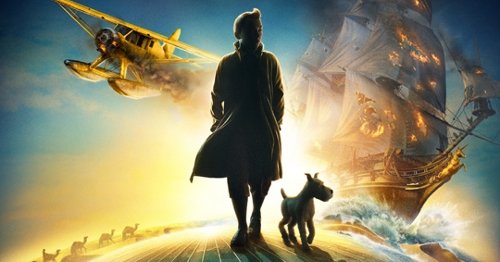
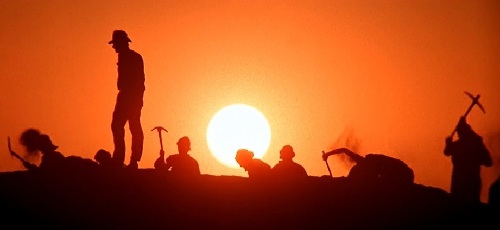
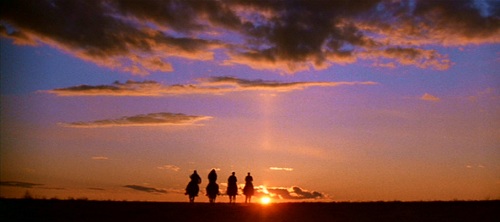
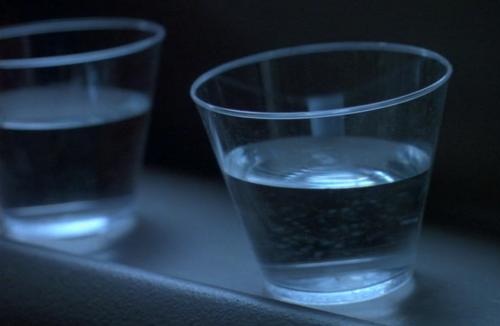
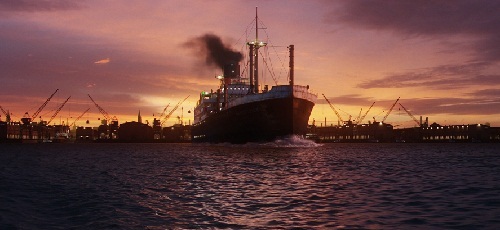
Fantastic post – Gosh there’s a lot to take in there! Nice grouping into themes. I must see the Tintin film – my daughter wasn’t keen so we didn’t see it at the cinema which was a mistake.
One thought on the continuity of mechanisms – I’m sure I’ve read that Spielberg did that deliberately in homage to all those old movies where there doesn’t seem to be enough room to get under, then back to shot and there’s more room and the hero escapes sort of thing.
Yes, stubbornly, I did not want there to be more posts on Spielberg than there were on Hitchcock, and now I find myself wanting to get into the meat of some of them more. Ah well, live and learn.
And, yes, I too really regret not seeing Tintin in theaters. In is certainly in contention for Best Desert Island film. There are so many great details in the animation, you could watch it over and over and still see something new.
Interesting about the continuity, that would make sense. I’m purposely trying to come at these with a fresh eye and not read too much them, but I now realize there must be tons of work out there on the Indiana Jones films because they are so rich with references that I didn’t pick up on at all when younger.